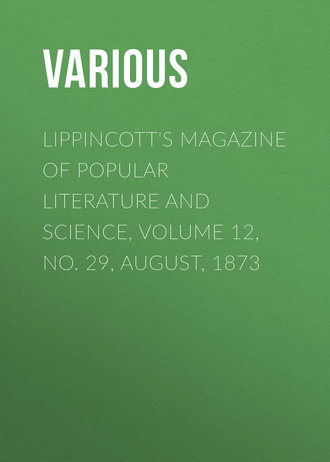 полная версия
полная версияLippincott's Magazine of Popular Literature and Science, Volume 12, No. 29, August, 1873
We found the areca trees planted in rows, and growing to the height of some forty feet, with straight, branchless trunks, terminated at the top with ten or twelve pinnated leaves, each of which is full five feet long. The fruit grows in clusters immediately below the tuft of leaves. The outer shell is of a bright golden hue, that gradually deepens to crimson as the fruit matures, and when opened shows a brown, astringent nut about the size of a nutmeg. This is the portion chewed with chunám and tobacco all over the East; and its use is so universal that one seldom meets a man, woman or child of any Oriental nation whose mouth is not filled, always and everywhere, with the execrable mixture. Pepper leaves are sprinkled with chunám (lime) and rolled up: a slice of betel-nut with a quid of tobacco is placed in the mouth first, and then the rolled-up leaf is bitten off, and all masticated together. When a visitor calls the betel-box is immediately passed to him; and as in regard to the eating of salt in Western Asia, so, in the eastern and southern portions, those who have once partaken of betel-nut together are ever after sworn to faithful and undying friendship. The use of the areca-nut preserves the teeth from decay, but keeps them stained of a disgusting brick-red color.
On the outer edge of Cassim's plantation, where the soil was damp, we noticed several long rows of the nepah palm, generally known as attap, and extensively used for thatching houses in the East. It has the same huge pinnated leaves as most of the other palms, but is destitute of the long straight trunk, the leaves commencing from near the root, and the entire height being seldom more than twelve or fourteen feet. We saw also a few specimens of the hutan, a strange-looking palmate shrub with leaves fifteen feet long, which are generally used by the Malays for sails, in lieu of canvas, for their piratical proas. But the strangest of all the palms we saw was the talipát, so called from the Bali word talipoin, a priest; and the name was originally derived from the fact that the sacred fans used by Booddhist priests in their religious ceremonies are formed of its leaves. This fan is a prescribed item of clerical costume, and no conscientious Booddhist priest ever appears without this long-handled fan held directly in front of his face, to prevent the sacred countenance from coming in contact with anything unclean. The sacred books of the Booddhists and Brahmins are also written on the talipát palm leaves, as are many of their historical records and scientific works. This mammoth tree sometimes reaches the height of nearly two hundred feet, and its trunk the circumference of twelve feet. It lives to the age of nearly a century, but blossoms only a single time; during the whole period of its existence. The flower, some thirty feet in length, bursts with a loud explosion at maturity, and in dying scatters the seeds that are to produce the next generation of trees. A single leaf will sometimes measure forty feet in circumference; and it is no unusual sight on the Malabar coast, where storms are so fierce and sudden, to see ten or fifteen men finding shelter in a boat over which is spread a single; palm leaf, which effectually shields all from both wind and rain. When the storm has subsided the huge leaf may be folded up like a lady's fan, and is so light as to be readily carried by a man under one arm. The talipát never grows wild, it is said, as do most of the other palms; and it reaches its greatest perfection in the island of Ceylon. All that I ever met with were under cultivation, being tended and nursed with the utmost care. Indeed, half a dozen talipát palm trees are a fortune in themselves, the leaves being very profitable as merchandise, while a crop may be gathered every year during a long life, and then the tree be of sufficient value to be bequeathed to the heirs of the owner.
Bidding adieu to our Malayan host, we once more entered the palanquins, and in a little while were set down on the coast, where lay our sampán with flag hoisted and pennons gayly flaunting in the breeze. First we passed Battu Bliah, "the sailing rock"—so called from its fancied resemblance to a ship under widespread canvas; then around an abrupt projection of Erskine's Hill, in a narrow passage between Singapore and Baltan Máteo, we came in full view of the promontory upon the highest point of which is built the palace-bungalow of the old sultan-rajah who held sway over the island previous to its purchase by Sir Stamford Raffles for the British government, in 1819. The old rajah has passed away, but the bungalow is still occupied by his son, a pensioner on the English Crown, and one of the most daring pirates in all that region—successful enough to have achieved a fame for prowess, but too crafty ever to be caught.
At Pulo Nánas, where we were to lunch, we found the cloth was already laid on the green grass under the protecting shadow of a huge orange tree, whose ripe golden fruit offered a dainty dessert. We took our seats with the "professor" at the head, and were soon discussing the merits of boiled chicken, fried fish, omelette, oysters, turtle eggs and sundry fruits and confections with the zest created by seven hours of active exercise in the open air. Then came the reaction, inclining every one more to repose than research, and the hours would probably have been dreamed away barren of adventures, had it not been for our indomitable professor. We had missed him but a moment, when suddenly he reappeared, holding at arm's length what seemed in the distance about a dozen brown, scaly snakes a yard long, all strung together. Simultaneously the entire company sprang to their feet and started for a race as this regiment of frightful reptiles was thrust into their midst by the radiant "dominie," whose face was fairly aglow with mischief. "Where did they come from? What are you going to do with them?" exclaimed everybody at once, turning to look at the monsters as they lay passive and motionless where the professor had thrown them. "Give them to Saint Patrick, to keep company with those he drove out of the Emerald Isle; or we'll have them for dinner if you prefer," was the laughing response. Reassured by the non-combatant air of the dreaded reptiles, we ventured a nearer approach, and our astonishment may readily be imagined when we found not snakes, but simply a cluster of the pendent blossoms of the rattan tree (Arundo bambos), one of the strangest of all the floral products of the tropics. They hang from the tree in clusters usually of ten or twelve, each a yard or more in length, looking like a soldier's aigrettes suspended among the green leaves, or perhaps still more like a string of chestnut-colored scales threaded through the centre. Waving to and fro in the summer breeze, as I afterward saw them, intertwined with the graceful tendrils of the beautiful passion-flower with its rare feathery chalice of purple and gold, and flanked on every side by ferns of exquisite symmetry, reflecting their dainty fringes in the clear waters, the tout ensemble is one of radiant loveliness, seemingly too fair to be hidden away among lonely jungles.
Consigning our newly acquired treasure to the keeping of the comprador, we sauntered forth in search of other discoveries, and were richly rewarded by finding several perfect specimens of the monkey-cup or pitcher-plant (Nepenthes distillatoria). This plant is found in moist places, such as are suited to the growth of ferns, mangroves and palmate shrubs. It has pendent from each leaf a natural pitcher or elongated cup, growing perfectly upright and capable of holding a pint or more of liquid. It is provided also with a natural cover, which when closed prevents the ingress of leaves or rubbish falling from other trees. The most curious circumstance connected with this strange plant is, that it is nearly always found full of pure, sparkling water, and that the lid closes of itself as soon as the receptacle is full, and opens whenever it is empty. The water is thus protected from dust, and kept always fit for the use of thirsty travelers, as well as of the immense troops of monkeys that inhabit tropical jungles. When the dainty cup has been drained of its refreshing contents, this wonderful little plant again throws wide the portals of its exhausted receptacle for the free entrance of rain or dew. Another plant, one we had often heard of, and sought for without success, the so-called oyster tree, was found, and proved to be nothing very wonderful after all. It is simply an ordinary oyster or other shell-fish, that, tired of lying in the mud, concludes by way of variety to try swinging in the air for a while, and so fastens itself to the long, pendent branches of the mangroves that grow luxuriantly on the shores of most tropical islands.
There seeming to be no more objects of interest to detain us at Pulo Nánas, and our chuliahs having already gone on to prepare dinner at Pulo Panjan, we rallied our forces and followed suit. It was already four o'clock, and so near the equinoctial line, where there is no twilight, it is dark soon after six; but then Pulo Panjan was on our route homeward, and we should have time at least to dine and gather some of the beautiful flowers for which the island is famous, as well as to taste the white pineapple, a rare and exquisite variety that grows here in great abundance. Both rind and pulp are of a pale straw-color; hence the name, to distinguish this species from the ordinary golden-colored fruit, which is far inferior to the white. Those we obtained were magnificent specimens—large and juicy, with a flavor to tempt the appetite of the veriest epicure. Abdallah peeled them in such a way as to remove the bur entire, and brought them to our grassy "board" on pure white porcelain plates garnished with wreaths of fragrant flowers. Never were the gods feasted on nectar and ambrosia more divinely luscious than the white pines and golden mangoes, the rich juicy grapes and sparkling sherbet, with which we were regaled on that bright summer eve at the base of the old flagstaff towering above our heads.
We had not much time for roaming, but gathered whole handfuls of the lotus or water-lily, with its pale-blue, golden or rose-tinted blooms gleaming up from the sparkling waters like the fabled charms of mermaid or sea-nymph. There are many varieties of this exquisite flower—blue, pink, carnation, bright yellow, royal purple fringed with gold, and, more beautiful than all, pure, virgin white, with the faintest possible rose tinge in the centre of each section of the corolla, a just perceptible blush, as of its own conscious loveliness. This last variety is the royal flower of Siam: it is borne before the king at weddings, funerals and all state festivals, and the royal reception-rooms are always beautifully decorated with the young buds arranged in costly vases of exquisite workmanship. The costly silk and lace canopies over the cradles of the infants of the king's family are also made in the form of a lotus reversed; and it is said that in cases of fever or eruptive diseases the leaves of the fresh lotus are spread over the royal couches, as being not only sanitary, but more agreeable to the invalid than the ordinary linen or silk bedding. Guided by the rare rich perfume of its waxen buds, we found a choice specimen of the bride-like moon-creeper, and bore if off, vine, blooms and all, to a place among the floral adornments of our own home.
We reached home at eight o'clock, after a cruise, by sea and by land, of thirteen hours; but the day had been so replete with enjoyment that we scarcely felt conscious of fatigue, and were off again the next morning, soon after sun-rise, for a ride to Bookit Timá ("hill of tin"), the central and loftiest peak of Singapore Island. It is nine miles from the city, with a smooth road to the very summit, so that we might go either in pony palanquins or on horseback. We chose the latter, as affording us better opportunity for observation and the collection of "specimens," and, as we could readily gain the mountain-top in season for a nine o'clock breakfast, the heat would not be oppressive. Abdallah despatched the chuliahs, each with a stout load of provisions, table-ware and cooking-utensils, at dawn, and when we arrived our déjeuner was ready to be served. The viands were tempting and the cookery faultless, but we could scarce do justice to either, so eager were we to begin our explorations on the summit and sides of this beautiful hill, or rather hills, for there are twin peaks closely connected, and each presenting an enchanting view of verdant fields and fertile valleys, of the neighboring city, the wide expanse of blue waters beyond, and the shipping in the harbor. Having satisfied ourselves with gazing at the distant prospect, we began to descend in search of adventures, sending our ponies ahead to await us at the base of the mountain, where we were to dine. Onward we strolled, gradually descending, every step marked by novelties—flowers, grasses, weeds and shrubs vieing with each other in varied and glad-some beauty. At length we sat down to rest beneath a huge bombax or cotton tree (Bombax ceiba), its widespread branches and thick foliage shielding us effectually from the noonday sun, a fragrant blossom falling occasionally into our laps or pelting us over head and shoulders, while with every passing zephyr the fleecy down from the ripe bolls floated hither and thither, looking for all the world like a snow-storm, except that the sun was shining luminously in the clear heavens. This tree must have been sixty feet in height, a grand, noble type of a green old age after scores of years well and usefully spent, still vigorous and productive. We met specimens afterward even taller and larger than this, and they are said sometimes to reach the height of a hundred feet. The timber is light and porous, and is in great demand for boats. Lower down, the various palms, especially the cocoa-nut and cabbage, were all about us. The former is found in nearly every tropical clime, and is of all trees the one most indispensable to the East Indian, furnishing him with meat, drink, medicine, clothing, lodging and fuel. The ripe kernel of the nut, besides being eaten, has expressed from it an excellent oil, that feeds all the lamps in an Oriental house, supplies the table with a most palatable substitute for butter, and the belle with a choice article of perfumery; the green nut affords a delicious beverage to the thirsty traveler; the fibrous covering of the nut is readily converted into strong and durable cordage, and the polished shells into drinking-cups, ladles and spoons; the leaves are frequently used for thatch, the wood for lathing and musical instruments, and the sap for toddy, an intoxicating drink very common in the East. The tree is graceful and pretty, with a tuft of large pinnated leaves at the top, and nestled cosily in their midst are the clusters of fruit. It grows to the height of forty or fifty feet, is long-lived, and bears fruit nearly the whole year round. The cabbage palm is much less common in a wild state, and few planters will take the trouble to cultivate it, since a whole tree must be destroyed to obtain a single dish. The edible part consists of snow-white flakes found just inside the bark near the top of the tree. When stewed in the expressed juice of the cocoa-nut it constitutes one of the most luscious dishes I have ever eaten. The tree is tall and large, and the pinnated leaves very long.
In the moist portions of the jungle toward the foot of the hill were whole groves of the fragrant pandanus, ferns of infinite variety, and a species of wild mignonette with a perfume like that of commingled strawberries and lemon. Now and then we paused beneath the thick green foliage of the Magnolia grandiflora, as it towered in stately grandeur above its sister flowers, acknowledged queen of the parterre, and dispensing with genuine Oriental profusion its rare and delicious perfume. A step farther and our gaze was riveted by the modest purity of the spotless japonica, the fragrant tuberose and Cape jessamine, the graceful passion-flower, with its royal beauty and storied reminiscences, the peerless dauk-málé, fragrant and fair, the Kalla Indica, with its five long petals of heavenly blue, the gold-plant of the Chinese, and crimson boon-gah-riah of the Malays, the last two consecrated symbols in the religious rites of those nations. What a medley of sweets, flaunting their gay colors in the bright tropical sunshine! Then the innumerable company of roses—tea, moss, perpetual, cluster, climbing, variegated, and a score of others—how fair, fresh and fragrant they are, peerless, queen-like still, even amid such a gorgeous array of ripe floral charms! These, and a thousand others for which we have no names in our language, are scattered profusely over those sunny lands of dreamy beauty, vieing with each other in rare, rich perfume, exquisite grace of form and matchless blending of their warm, ripe colors.
The next day we dined at Dr. Almeida's, and in his magnificent garden found several choice specimens of both the Victoria regia and the Rafflesia Arnoldi, the two largest flowers in the world, each bloom measuring two feet in diameter. But the rarest of all the doctor's treasures was the night-blooming cereus. There were six blooms in full maturity—four on one stalk and two on another—creamy, waxen flowers of exquisite form, the leaves of the corolla of a pale golden hue and the petals intensely white. The calyx rises from a long, hollow footstalk, which is formed of rough plates overlapping each other like tiles on a roof. From the centre of this footstalk rises a bundle of filaments that encircle the style, stamens springing also from the insertion of the leaves of the corolla, lining it with delicate beauty and waving their slender forms with exquisite grace. But the real charm of the cereus is its wondrous perfume, exhaled just at night-fall, and readily discernible over the circuit of a mile. The peculiar odor cannot be understood by mere description, but partakes largely of that of sweet lilies, violets, the tuberose and vanilla. After the bud appears the growth is very rapid, often two or three inches a day—that is, in the height of the stalk, the flower expanding proportionately. When fully grown it begins to unfold its charms as the twilight deepens into night, and reaches perfect maturity about an hour before midnight: at three o'clock its glory is already beginning to wane, though scarcely perceptibly; but at dawn it is fading rapidly, and by sun-rise only a wilted, worthless wreck remains, good for nothing but to be "cast out and trodden under foot of men."
FANNIE R. FEUDGE.A PRINCESS OF THULE
CHAPTER XII.
TRANSFORMATION
Had Sheila, then, Lavender could not help asking himself, a bad temper, or any other qualities or characteristics which were apparent to other people, but not to him? Was it possible that, after all, Ingram was right, and that he had yet to learn the nature of the girl he had married? It would be unfair to say that he suspected something wrong about his wife—that he fancied she had managed to conceal something—merely because Mrs. Lavender had said that Sheila had a bad temper; but here was another person who maintained that when the days of his romance were over he would see the girl in another light.
Nay, as he continued to ask himself, had not the change already begun? He grew less and less accustomed to see in Sheila a beautiful wild sea-bird that had fluttered down for a time into a strange home in the South. He had not quite forgotten or abandoned those imaginative scenes in which the wonderful sea-princess was to enter crowded drawing-rooms and have all the world standing back to regard her and admire her and sing her praises. But now he was not so sure that that would be the result of Sheila's entrance into society. As the date of a certain dinner-party drew near he began to wish she was more like the women he knew. He did not object to her strange sweet ways of speech, nor to her odd likes and dislikes, nor even to an unhesitating frankness that nearly approached rudeness sometimes in its scorn of all compromise with the truth; but how would others regard these things? He did not wish to gain the reputation of having married an oddity.
"Sheila," he said on the morning of the day on which they were going to this dinner-party, "you should not say like-a-ness. There are only two syllables in likeness. It really does sound absurd to hear you say like-a-ness."
She looked up to him with a quick trouble in her eyes. When had he spoken to her so petulantly before? And then she cast down her eyes again, and said submissively, "I will try not to speak like that. When you go out I take a book and read aloud, and try to speak like you; but I cannot learn all at once."
"I don't mind," he said. "But you know other people must think it so odd. I wonder why you should always say gyarden for garden now, when it is just as easy to say garden?"
Once upon a time he had said there was no English like the English spoken in Lewis, and had singled out this very word as typical of one peculiarity in the pronunciation. But she did not remind him of that. She only said in the same simple fashion, "If you will tell me my faults I will try to correct them."
She turned away from him to get an envelope for a letter she had been writing to her father. He fancied something was wrong, and perhaps some touch of compunction smote him, for he went after her and took her hand, and said, "Look here, Sheila. When I point out any trifles like that, you must not call them faults, and fancy I have any serious complaint to make. It is for your own good that you should meet the people who will be your friends on equal terms, and give them as little as possible to talk about."
"I should not mind their talking about me," said Sheila with her eyes still cast down, "but it is your wife they must not talk about; and if you will tell me anything I do wrong I will correct it."
"Oh, you must not think it is anything so serious as that. You will soon pick up from the ladies you will meet some notion of how you differ from them; and if you should startle or puzzle them a little at first by talking about the chances of the fishing or the catching of wild-duck, or the way to reclaim bogland, you will soon get over all that."
Sheila said nothing, but she made a mental memorandum of three things she was not to speak about. She did not know why these subjects should be forbidden, but she was in a strange land and going to see strange people, whose habits were different from hers. Moreover, when her husband had gone she reflected that these people, having no fishing and no peat-mosses and no wild-duck, could not possibly be interested in such affairs; and thus she fancied she perceived the reason why she should avoid all mention of those things.
When in the evening Sheila came down dressed and ready to go out, Lavender had to admit to himself that he had married an exceedingly beautiful girl, and that there was no country gawkiness about her manner, and no placid insipidity about her proud and handsome face. For one brief moment he triumphed in his heart, and had some wild glimpse of his old project of startling his small world with this vision from the northern seas. But when he got into the hired brougham, and thought of the people he was about to meet, and of the manner in which they would carry away such and such impressions of the girl, he lost faith in that admiration. He would much rather have had Sheila unnoticeable and unnoticed—one who would quietly take her place at the dinner-table, and attract no more special attention than the flowers, for example, which every one would glance at with some satisfaction, and then forget in the interest of talking and dining. He was quite conscious of his own weakness in thus fearing social criticism. He knew that Ingram would have taken Sheila anywhere in her blue serge dress, and been quite content and oblivious of observation. But then Ingram was independent of those social circles in which a married man must move, and in which his position is often defined for him by the disposition and manners of his wife. Ingram did not know how women talked. It was for Sheila's own sake, he persuaded himself, that he was anxious about the impression she should make, and that he had drilled her in all that she should do and say.









